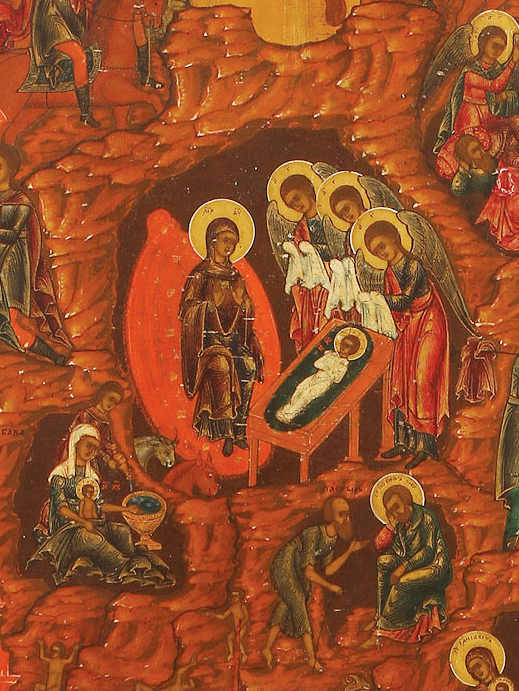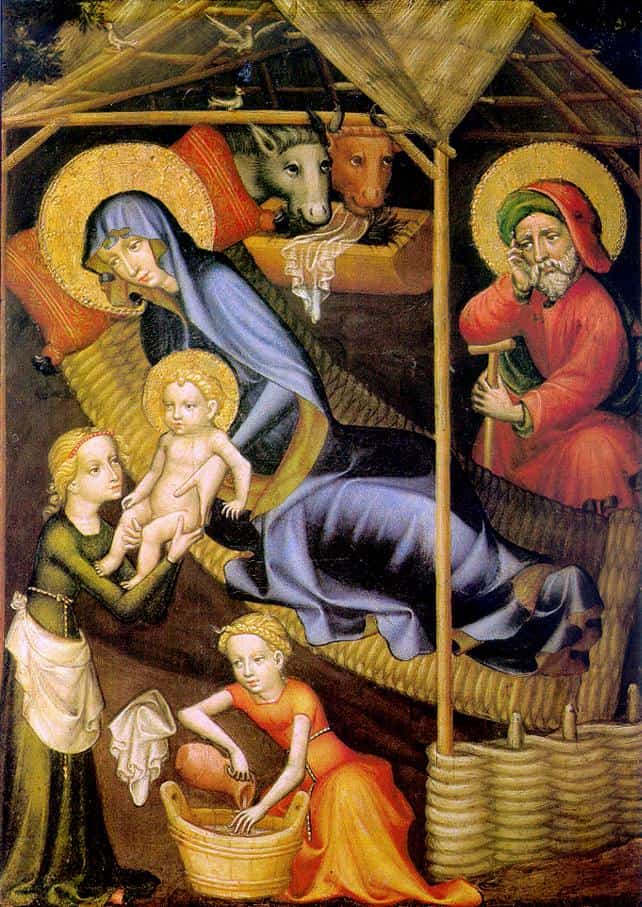by Christine Sine
Just before Christmas I set up our Nativity set and added Jesus in the manger to my Advent garden. I also took out the Advent candles and replaced them with white ones, instantly converting it into a Christmas garden. Where’s the midwife I pondered as I got ready to celebrate the twelve days of Christmas? Mary’s midwife is not a piece of the nativity sets we use to decorate our homes during the Christmas season, though evidently she did often appear in Ancient Orthodox and Byzantine icons of the event.
While it’s true that Luke doesn’t mention the presence of a midwife in his account of the nativity, it’s not hard to imagine that Mary was attended by one, just as Jewish mothers had been for thousands of year.

Russian icon titled Rozhestvo Gospoda Nashego Isusa Khrista — “the Birth of Our Lord Jesus Christ
It’s probable that Mary and Joseph had already been in Bethlehem for several days when Jesus was born. Luke says plainly, “And Joseph also went up from Galilee, from the city of Nazareth, to Judea, to the city of David, which is called Bethlehem … And while they were there, the time came for her to be delivered” (Luke 2: 4-6). There is no sense of urgency in the account, no indication that she was already in labour when they arrived. It is probable that Mary and Joseph had ample time to prepare for her delivery and to seek out a local midwife. It is even likely that some of Joseph’s female relatives were there. After all this was his home town and whether Jesus was born in a cave where animals were kept, or in a family home, as I suspect, in a culture as hospitable as this they would not have been left to birth the baby on their own.
Like so many other figures in the gospel narrative, this midwife is never named, though Orthodox tradition calls her Salome. Sometimes she is depicted in the corner or background of the manger scene. Sometimes she’s preparing something for Mary, sometimes observing quietly, and sometimes giving Jesus his first bath! Irish tradition says that it was Brigid of Kildare who somehow travelled through time and space to be with Mary and deliver this precious child. This unknown woman, was vital to the survival of Jesus.

The Nativity. The Virgin Mary and the Baby Jesus in a manger, with Joseph. From the Nagara Māryām, the history and miracles of the Blessed Virgin Mary, 18th century
As I sit here today, thinking of this woman, I am reminded of my early days as a physician in New Zealand when I too helped to bring babies into the world. It was the most precious experience imaginable, one that I never tired of. So I close my eyes and imagine myself transported back 2,000 years to give birth to that special child. After all if Brigid can travel through time I should be able to as well. I imagine myself comforting Mary as she cried out in the pangs of childbirth. I imagine listening for Jesus’s first breath, and hear him give his first cry. I bath him, gently wiping off the blood and fluids of his passage through the birth canal. Then I lay him on his mother’s breast, enthralled by her radiant smile and I beckon Joseph to her side.
It is hard to believe, as we think of this tiny child, so rudely and violently expelled into the world, and now lying quietly in all his vulnerability and dependency, that he is indeed the promised saviour, the son of God. Like me, did the midwife look at his tiny body in awe and wonder filled with the joy and delight of helping to bring to birth a child in whom the divine spark was obviously present. Did she go away changed just as the shepherds and the wise men were changed by their encounter? Did she cherish the face of this child in her mind aware that he was special and would transform the world?
I love that we have 12 days in the Christmas season to contemplate the many remarkable aspects of the birth of Christ. I pray that you too will take time today to think about not just Jesus but also the woman who helped bring him into the world. I suspect she holds a very special place in the heart of God.

